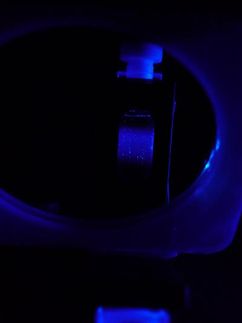New infrared marker for bio-imaging
he recently developed fluorescent protein Amrose is now being used for advanced near-IR imaging procedures. With the aid of a novel evolutionary platform technology, scientists at the Helmholtz Zentrum München have developed this infrared marker as part of a combined effort to improve the quality of tissue imaging. The results have been published in the scientific journal PLOS ONE.
Far-red shifted fluorescent tissue markers make it possible to visualize structures and processes with advanced bio-imaging. This permits new insights into organisms and creates the potential for a wide range of applications – from more exact delineation of tumor and metastasis through to tracking drug responses within whole-body imaging.
The team of scientists headed by Dr. Ulrike Schoetz, Dr. Nikolas Deliolanis, Dr. Wolfgang Beisker, Professor Horst Zitzelsberger und Randolph Caldwell from the Helmholtz Zentrum München have succeeded in developing novel fluorescent markers that excite in the far-red and emit in the infrared spectrum. Depending on the light spectrum used and the organism under examination, these can now deliver better-quality images. The tests confirming the spectral properties were conducted in cooperation with the Max Planck Institute for Neurobiology (Martinsried) and the Federal Institute for Materials Research and Testing (Berlin).
Amrose variants with different spectral properties
A high level of diversification occurs naturally in the B cells of the immune system, which produce antibodies. When genetic material is introduced into these cells, this evolutionary mechanism can be co-opted to create new genetic and protein variants. The scientists were thus able to transfer the genetic information from the known fluorescent protein eqFP615 into the DT40 chicken B cell line in order to produce protein variants of the new infrared marker Amrose with different spectral properties.
“Here we have demonstrated the further use of this novel technology to develop highly sought after biologically relevant fluorescent markers quickly and easily for different imaging needs,” says Caldwell, who led the study.
The Helmholtz Zentrum München aims to make basic research findings available quickly for clinical application as well as to develop new approaches to diagnostic and therapeutic procedures and prevention.
Original publication
Other news from the department science

Get the life science industry in your inbox
By submitting this form you agree that LUMITOS AG will send you the newsletter(s) selected above by email. Your data will not be passed on to third parties. Your data will be stored and processed in accordance with our data protection regulations. LUMITOS may contact you by email for the purpose of advertising or market and opinion surveys. You can revoke your consent at any time without giving reasons to LUMITOS AG, Ernst-Augustin-Str. 2, 12489 Berlin, Germany or by e-mail at revoke@lumitos.com with effect for the future. In addition, each email contains a link to unsubscribe from the corresponding newsletter.



















































